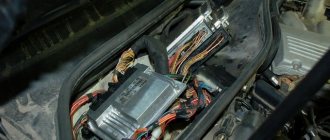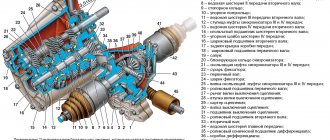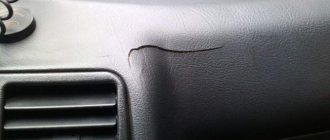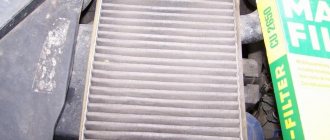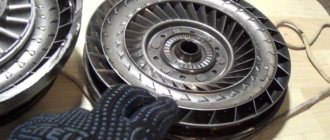Let's start with the fact that one of the most common transmission-related problems is transmission noise or transmission hum. This problem is well known to many owners of cars with manual transmission, and quite often a vehicle with a humming gearbox is quite suitable for further use.
In other words, if a manual transmission is humming, but the unit itself is working normally, the gearbox is often used for quite a long time without repair. As for automatic transmissions of various types and types, in this case the appearance of automatic transmission hum and noise is a more serious problem.
Next, we will look at why the automatic transmission is noisy or humming, for what reasons the automatic transmission hum appears at speed, during gear shifts, etc., as well as what the owner should do in such a situation.
Why is the automatic transmission “noisy” - When driving or shifting?
When operating a vehicle, it is necessary to monitor the functions of each unit and vehicle systems. Experienced drivers can understand the condition of the transmission of a running car by the nature of the sounds produced by each mechanism. Listening to the car is carried out both while driving and when the car is stopped. A working automatic transmission makes almost no extraneous knocking, noise, squeaks, vibrations, etc. If the automatic transmission is noisy, diagnostics must be carried out to prevent damage to the components and parts of the gearbox.
conclusions
The howling of a Renault, Lada Vesta, Grant or any other car is a problem that cannot be ignored. A working transmission does not make any strange sounds, so if they appear, go to a service center as soon as possible. The sooner the diagnosis is carried out, the cheaper the repair will cost. If you constantly postpone this event, then the howl may end in buying a new box.
The gearbox is a rather complex unit, especially when it comes to an automatic transmission. Do not trust repairs and diagnostics to random people. It is better to contact a specialized auto repair shop that has the necessary equipment and tools.
VAZ checkpoint, a frequent source of howling.
Worn synchronizers are a source of increased noise. For replacement.
A worn input shaft bearing is another enemy of silence.
A faulty release bearing is a frequent source of additional noise.
edit this post
Determining the nature of the malfunction by sound
In addition to the skills in qualified repair work, the responsibilities of auto mechanics at service centers also include the ability to diagnose vehicle components. Experienced technicians must accurately determine the area where breakdowns occur in automatic transmissions and the degree of their neglect. From a wide variety of sounds, it is necessary to identify suspicious non-standard noises emanating from a faulty car transmission.
To eliminate noise that is not related to the stable operation of the automatic transmission, the mechanic first checks the following devices:
When identifying the causes of unusual noise in an automatic transmission, both during movement and during a stop with the engine running, an experienced technician pays attention to:
The cause of the noise when the automatic transmission is engaged in reverse gear is also checked. The results obtained during the diagnostic process provide the basis for an accurate assessment of the structure and degree of damage to the automatic transmission.
Separation of the noise of a working automatic transmission by type
Depending on the nature of the sound of the automatic transmission, unusual noises are divided into the following categories:
Features of noise from automatic transmissions, determination of the nature of breakdowns, methods for eliminating them
When stopping a vehicle, you can often hear a sound similar to the piercing wail of a siren. This type of noise occurs when the torque converter is operating. This signal should not cause much concern to the driver if it is short-term in nature. The appearance of an incessant howl, changing the tone depending on the engine speed, indicates the appearance of serious defects in the automatic transmission:
What causes the buzzing noise? It has been noted that the intensity of noise of this type depends on the rotation speed of the output shaft of the power unit. They arise due to increased vibration and oscillations of the line pressure oil valve (regulator valve). To eliminate unpleasant noise, it is necessary to replace thinned oil seals, cuffs and other sealing elements that have failed.
Continuous rattling appears when the engine is running at low speeds. In this case, you need to check:
What do metallic clanging noises indicate when idling? Typical causes here are worn clutch friction disc gaskets. To eliminate this defect and replace the clutch packs, you will have to dismantle the automatic transmission using special lifting equipment in a service station.
The hum and rattle in the area where the differential mechanism is located is the result of problems arising in this device:
What does the noise in the automatic transmission indicate when you engage a gear or change from one mode to the next? The main reason is a malfunction of the operating gear elements in the corresponding rows of the planetary mechanism. When noises change in volume and pitch when the next gear is engaged or the automatic transmission selector is switched to reverse mode, most likely the thrust bearings (liners) have become unusable.
Eliminating noise
Let's look at the signs and corresponding breakdowns of the gearbox in the VAZ 2109
| Signs |
Replacing the drive shaft bearing
If you decide to repair the drive shaft bearing yourself, then for this you will need a hammer, a vice, and a bearing puller. Let's start the repair:
First you need to dismantle and disassemble your gearbox; then take the drive shaft and clamp it in a vice
Attention! The vice must have soft metal pads; the rear bearing must be pressed using a special puller; then turn the shaft over and compress the inner race of the primary bearing in the same way; Now you need to push the rear bearing all the way onto the shaft. This is done using a metal mandrel and a hammer; the same operation must be done with the inner ring of the front bearing.
Reasons for a howling sound in a gearbox
Sooner or later, any car owner has to face a situation when the gearbox in his car begins to howl.
The hum may be moderate, but if no action is taken, it will inevitably increase, which can lead to serious damage and expensive repairs. What are the main signs of this and how to eliminate them?
Causes of howling in a manual transmission. Many manual transmissions, even when at rest, are not very quiet. Sometimes when using a new car, the transmission can make certain sounds, this is especially common on vehicles in the budget segment. For example, the whine of a gearbox on a VAZ is the norm for many cars. Every car owner knows what the normal noise level is in the cabin and will immediately notice changes. If the hum of the box begins to change tone, competes in volume with the sound of the engine, or occurs under some special conditions, then you need to think about visiting a car service center.
Many drivers may make the mistake of confusing the howling gearbox with malfunctions of other elements. Often, a howling sound can be made by a release bearing with a certain degree of wear. The volume and tone of the noise produced are directly dependent on the speed of movement, which leads to the erroneous diagnosis of “box howling”. The same problem can be caused by a clutch that requires replacement. Without diagnostics, it is not easy to find out what exactly is causing this behavior, so the best option would be to contact a repair shop.
If the hum is produced by the manual transmission itself, then the reasons may be as follows:
If the howling does appear, it is worth paying attention to when it occurs, whether there is a change in its tone and volume in different modes.
The reasons for the howling of an automatic transmission, robot or variator. Automatic transmissions in normal condition are much quieter than manual ones. The occurrence of extraneous sounds from the automatic transmission should make the owner wary. Diagnosing the reason for this is not so easy, but many simply do not contact a car service, drowning out extraneous sounds with loud music.
What to do if the box howls
The first thing a car owner should think about when a howling noise appears in the transmission is a transmission fluid leak. Inspect the car's riser for oil stains, assess the oil level in the box using the dipstick, which most car models have. If the transmission fluid level is below the minimum mark, it must be topped up immediately. Use only the brand of oil that comes in the box. You cannot mix liquids from different manufacturers. You should know that automatic transmissions are very sensitive to the level of lubrication, so an overflow of transmission fluid is as unacceptable as a lack of it. If the oil has not been changed for a long time, it should be done. Automatic transmissions are especially sensitive to the quality of transmission fluid.
If it was not possible to eliminate the howling of the box by replacing or adding oil, you need to go to a service station for diagnostics. Specialists will assess the condition of the transmission and tell you how much repair is needed.
If you decide to sort through the box, you should take into account that the cost of such work is quite high. That is why it is advisable to purchase new original spare parts. Only in this case can you count on a long service life of the transmission after repair. Buying used spare parts or cheap parts from a dubious manufacturer is an imaginary savings. There is a high probability that soon after such repairs the gearbox will have to be disassembled again.
If the main pair is damaged, it is rarely possible to get by only by replacing it. Usually in such a situation other parts also suffer, so you need to evaluate their condition and, if necessary, also replace them.
Sometimes repairing a box turns out to be very difficult and expensive. In this case, it is advisable to replace the entire transmission. You can buy a new unit or find a used box in working condition.
Automatic transmission hums at speed: main reasons
Let's start with the fact that one of the most common transmission-related problems is transmission noise or transmission hum. This problem is well known to many owners of cars with manual transmission, and quite often a vehicle with a humming gearbox is quite suitable for further use.
In other words, if a manual transmission is humming, but the unit itself is working normally, the gearbox is often used for quite a long time without repair. As for automatic transmissions of various types and types, in this case the appearance of automatic transmission hum and noise is a more serious problem.
Next, we will look at why the automatic transmission is noisy or humming, for what reasons the automatic transmission hum appears at speed, during gear shifts, etc., as well as what the owner should do in such a situation.
Lack of oil
Another common cause of noise in the gearbox is insufficient oil level. In order to solve this problem, you just need to add oil.
The source of noise can be worn seals and mechanisms. To fix the problem, they need to be replaced with new ones.
Checking the oil level
In some cases, problems occur during gear shifting. Here you first need to look at the drive rods. It is possible that they have already used up their resource and need to be replaced. After this, you need to check the reliability of the hinge fastening. It wouldn't hurt to take a look at the gearshift lever rod.
Automatic transmission noise or automatic transmission hum: reasons
So, while operating a car with an automatic transmission, the owner must necessarily record all failures and irregularities that may occur during operation of this type of transmission. A working automatic transmission should not normally produce any extraneous noise, knocking, hum, vibration, grinding, etc.
It is quite obvious that malfunctions and malfunctions can cause serious breakdowns or complete failure of the automatic transmission. At the same time, automatic transmission repair is also expensive. Naturally, the appearance of extraneous sounds during operation of an automatic transmission is an alarming symptom, and such signs cannot simply be ignored for some time (similar to similar problems with manual transmissions).
Also, in some cases, if noise, hum or knocking appears in the automatic transmission, you must immediately stop using the vehicle. This means that continuing to move under your own power is not recommended. To more accurately determine what the reason is and how to proceed, you must first listen to how the car’s transmission works. You need to listen to the box both at idle and while driving.
Lack of oil
Another common cause of noise in the gearbox is insufficient oil level. In order to solve this problem, you just need to add oil.
The source of noise can be worn seals and mechanisms. To fix the problem, they need to be replaced with new ones.
In some cases, problems occur during gear shifting. Here you first need to look at the drive rods. It is possible that they have already used up their resource and need to be replaced. After this, you need to check the reliability of the hinge fastening. It wouldn't hurt to take a look at the gearshift lever rod.
How to identify automatic transmission faults by sound
The ability to diagnose a unit by sounds applies not only to the engine, but also to the gearbox, as well as other components of the vehicle. The automatic machine is also no exception. This approach allows you to quickly identify suspicious automatic transmission noises in the event of malfunctions and, in some cases, localize the breakdown.
If the noise definitely comes from the automatic transmission, you need to pay attention to its frequency, tone and volume. You should evaluate the operation of the transmission in motion under load in different modes, also turn it on and drive in reverse gear, listen to how the automatic transmission works at idle.
For example, when braking, you can hear a loud sound similar to a howl. This noise is associated with the torque converter and is often not a serious problem if it occurs only briefly. If the automatic transmission howls constantly, and the tone changes depending on the engine speed, then this may indicate the following automatic transmission problems:
Also, in some cases, the automatic transmission buzzes. Moreover, the intensity of such sound directly depends on the speed of rotation of the output shaft. Such noises arise as a result of increased vibration, as well as oscillations of the line pressure valve (regulator valve). To get rid of the problem, it is often enough to replace the seals, cuffs and other sealing elements.
Often rattling can be heard in the automatic transmission, especially when the engine is running at low speeds. In this case, diagnostics of the gas turbine engine is needed to determine its performance. Possible problems include damage to the hydraulic pump blades, problems with the turbine wheel, and malfunctions of the damper springs.
Even when idling, you can hear the clanging of metal in the automatic transmission area. Often the cause is clutch gaskets (friction discs) that are sufficiently worn out. To eliminate such automatic transmission clanging, you need to change the clutches in batches. This operation involves removing the automatic transmission.
You can also often hear a hum and grinding noise in the differential area. This noise is often mistaken for wheel bearing noise. If the automatic transmission differential hums, this may indicate that the gear teeth, bearings and other elements of the mechanism are worn out.
If the noise changes (becomes louder, the pitch changes) when the automatic transmission selector is switched to R (reverse) mode, this often indicates that there are problems with the thrust bearings (liners).
Why does the box howl and make noise?
The main source of noise of varying tones in the VAZ 2109 gearbox is worn out or unadjusted components. Typically, such malfunctions occur on cars with high mileage.
The main reasons why the gearbox on a VAZ 2109 rattles or makes noise are:
- Reduced lubrication level. If the amount of oil is insufficient or its condition is unsatisfactory, the gears and bearings begin to work without a lubricating film, which causes a high-frequency whine of the gearbox. A pair of gears and the fifth gear shaft, located at the maximum height from the lubricant level in the manual transmission housing, are especially susceptible to this phenomenon. When the amount of oil drops significantly, all speeds begin to howl. Sometimes the sound is present only when the box is cold and disappears as it warms up. This is a sign that the liquid is too thick and hardens at low temperatures. Very thin oil, on the other hand, will cause a loud whine as it warms up.
- Worn drive shaft bearings. This is one of the most common causes of rustling noise when the gearbox is operating. The gearbox makes noise when coasting or when the car is stationary and idling.
- Wear of gears in the box. If the gearbox hums in certain gears, then the cause should be sought in wear or chipping of the gear teeth.
- Faulty locking rings. These parts are installed on the lateral conical surfaces of the secondary shaft gears of the box. They have gaps and can rotate freely along with the breadcrumbs. When the ring wears out, cracks and deformations may appear on it, which is why gears begin to shift with a bang.
- Worn synchronizer clutch. If the synchronizer itself fails, a cracking sound appears when gears are engaged and spontaneous speed loss occurs. To eliminate this defect, it is necessary to replace parts.
- Incorrect clutch adjustment. If the setting of the mechanism does not correspond to the norm, then the disks do not turn off completely when the pedal is pressed to the bottom position. In this case, a crunching sound is observed during switching and a characteristic foreign smell is felt due to the burning of the disks.
- . There is a rustling noise or rumble, but it disappears when the driver depresses the clutch pedal.
Noise additive in gearbox
As you can see, you can give an affirmative answer to the question whether the automatic transmission can hum. At the same time, as in any other unit, noise in an automatic transmission can appear for various reasons (wear, malfunctions, loss of properties of ATF transmission oil, etc.). It is also a common situation when noise appears in the automatic transmission after changing the oil. This is often due to the fact that unsuitable oils are used, errors were made during replacement, etc.
Owners often note that noise in the automatic transmission occurs in neutral and in parking; in some cases, noise in the automatic transmission appears when the car is stationary or in motion when the gear is engaged. It also happens that the problem manifests itself only under certain conditions and modes (for example, noise in the automatic transmission when engaging reverse gear or howling of the automatic transmission during acceleration).
Moreover, the list of “childhood” diseases allows you to quickly find out why the gearbox on a Lada Granta or other car with a manual transmission is humming. At the same time, diagnosing a manual transmission actually does not take much time. The repair itself is also often limited to changing the oil and replacing the manual transmission clutch or, in the worst case, rebuilding the transmission and replacing worn parts.
As is known, an additive in a manual transmission to reduce noise or an additive in the transmission oil of an automatic transmission in some cases can reduce or completely eliminate the appearance of extraneous sounds. In practice, manufacturers of such compounds promise normalization of unit operation, increased service life, softer and smoother operation of the automatic transmission, etc.
There are a large number of products from different manufacturers on the market, and among additives for automatic transmissions we can single out Liqui Moly and Xado. In the first case, the Liqui Moly ATF Additive is quite popular.
This additive in automatic transmissions has a positive effect on the oil, slows down its aging and oxidation, and also helps restore the elasticity of rubber and plastic seals. This property makes it possible to stop oil leaks through oil seals, gaskets and seals.
Why does the box howl and make noise?
The main source of noise of varying tones in the VAZ 2109 gearbox is worn out or unadjusted components. Typically, such malfunctions occur on cars with high mileage.
The main reasons why the gearbox on a VAZ 2109 rattles or makes noise are:
- Reduced lubrication level. If the amount of oil is insufficient or its condition is unsatisfactory, the gears and bearings begin to work without a lubricating film, which causes a high-frequency whine of the gearbox. A pair of gears and the fifth gear shaft, located at the maximum height from the lubricant level in the manual transmission housing, are especially susceptible to this phenomenon. When the amount of oil drops significantly, all speeds begin to howl. Sometimes the sound is present only when the box is cold and disappears as it warms up. This is a sign that the liquid is too thick and hardens at low temperatures. Very thin oil, on the other hand, will cause a loud whine as it warms up.
- Worn drive shaft bearings. This is one of the most common causes of rustling noise when the gearbox is operating. The gearbox makes noise when coasting or when the car is stationary and idling.
- Wear of gears in the box. If the gearbox hums in certain gears, then the cause should be sought in wear or chipping of the gear teeth.
- Faulty locking rings. These parts are installed on the lateral conical surfaces of the secondary shaft gears of the box. They have gaps and can rotate freely along with the breadcrumbs. When the ring wears out, cracks and deformations may appear on it, which is why gears begin to shift with a bang.
- Worn synchronizer clutch. If the synchronizer itself fails, a cracking sound appears when gears are engaged and spontaneous speed loss occurs. To eliminate this defect, it is necessary to replace parts.
- Incorrect clutch adjustment. If the setting of the mechanism does not correspond to the norm, then the disks do not turn off completely when the pedal is pressed to the bottom position. In this case, a crunching sound is observed during switching and a characteristic foreign smell is felt due to the burning of the disks.
- Worn release bearing. There is a rustling noise or rumble, but it disappears when the driver depresses the clutch pedal.
What's the result?
As you can see, automatic transmission noise is often a sign of a malfunction, rather than natural wear and tear of the unit. In this case, the hum in the automatic transmission is the basis for stopping the operation of the vehicle and conducting in-depth diagnostics.
You need to understand that normally the automatic transmission should not hum or make noise; only a monophonic sound is allowed, which is uniform. If, against the background of the normal sound of the operating unit, extraneous noises begin to be heard, this indicates problems with lubrication or malfunctions of automatic transmission parts.
Finally, we note that the habit of listening to the sounds and noises of the transmission, engine and other units allows you to identify problems at the initial stage when certain signs first appear. In the case of automatic transmissions, this allows you to avoid serious problems and significantly save the money needed to repair the automatic transmission.
Why the automatic transmission kicks, the automatic transmission jerks when changing gears, jerks, jerks and impacts occur in the automatic transmission: the main reasons.
How to determine that the automatic transmission is overheating: signs indicating overheating of the automatic transmission. How to improve automatic transmission cooling and prevent the machine from overheating.
Automatic transmission slipping when changing gears: the main reasons why an automatic transmission slips. Box diagnostics, troubleshooting.
A jolt in the automatic transmission, the appearance of jerks when shifting gears of the automatic transmission, jolts of the automatic transmission in place: the main reasons for such malfunctions of the automatic transmission.
The automatic transmission does not change gears: the car does not move forward or backward, the automatic transmission does not switch to individual gears, reasons.
Reasons for difficulty shifting gears with the engine running. Transmission oil and level in the gearbox, wear of synchronizers and gearbox gears, clutch.
Source
Why does the box howl and make noise?
The main source of noise of varying tones in the VAZ 2109 gearbox is worn out or unadjusted components. Typically, such malfunctions occur on cars with high mileage.
The main reasons why the gearbox on a VAZ 2109 rattles or makes noise are:
- Reduced lubrication level. If the amount of oil is insufficient or its condition is unsatisfactory, the gears and bearings begin to work without a lubricating film, which causes a high-frequency whine of the gearbox. A pair of gears and the fifth gear shaft, located at the maximum height from the lubricant level in the manual transmission housing, are especially susceptible to this phenomenon. When the amount of oil drops significantly, all speeds begin to howl. Sometimes the sound is present only when the box is cold and disappears as it warms up. This is a sign that the liquid is too thick and hardens at low temperatures. Very thin oil, on the other hand, will cause a loud whine as it warms up.
- Worn drive shaft bearings. This is one of the most common causes of rustling noise when the gearbox is operating. The gearbox makes noise when coasting or when the car is stationary and idling.
- Wear of gears in the box. If the gearbox hums in certain gears, then the cause should be sought in wear or chipping of the gear teeth.
- Faulty locking rings. These parts are installed on the lateral conical surfaces of the secondary shaft gears of the box. They have gaps and can rotate freely along with the breadcrumbs. When the ring wears out, cracks and deformations may appear on it, which is why gears begin to shift with a bang.
- Worn synchronizer clutch. If the synchronizer itself fails, a cracking sound appears when gears are engaged and spontaneous speed loss occurs. To eliminate this defect, it is necessary to replace parts.
- Incorrect clutch adjustment. If the setting of the mechanism does not correspond to the norm, then the disks do not turn off completely when the pedal is pressed to the bottom position. In this case, a crunching sound is observed during switching and a characteristic foreign smell is felt due to the burning of the disks.
- Worn release bearing. There is a rustling noise or rumble, but it disappears when the driver depresses the clutch pedal.
Conclusion
As a result, I would like to emphasize the main thing: you should not neglect all kinds of signals that may come from the gearbox, in the form of howling, knocking or special markings on the “tidy”. In the end, repairs can be much more expensive.
In addition, trust the diagnostics, and therefore the disassembly of the box, only to certified or verified services, avoid the so-called “garage” repairmen, from whom you can only get a new “portion” of problems.
Automatic transmission malfunctions
There are completely different signs of automatic transmission malfunction , which can give car owners the necessary information about the nature of the breakdown. For example, if there are problems with the valve body, significant shocks appear when changing gears. Moreover, such shocks are progressive in nature and at the initial stages of the breakdown are barely noticeable, and as the problem progresses, such shocks become more and more noticeable. If there are such problems with an automatic transmission, the car owner needs to contact the appropriate service center as soon as possible, whose specialists will carry out all the necessary repair work.
Automatic transmission malfunctions can also be expressed in the complete impossibility of switching gearbox operating modes or blocking operation in a certain gear. In this case, the car owner needs to transport the broken down car using a tow truck. It is not recommended to drive a car with a broken transmission on your own, as this can lead to serious damage to the drive and the automatic transmission itself.
Never drive a car with a broken transmission
In some cases, a malfunction can be diagnosed using built-in automatic sensors in the automatic transmission. Such sensors indicate insufficient oil pressure in the system, overheating, or problems with gear shifting. At the same time, it must be said that most of these reports of problems with the gearbox are not specific in nature, and it is not possible to make an accurate diagnosis of the breakdown in this case even when using professional computer equipment. The technician will need to inspect the transmission, dismantle it, and only after opening it will he be able to determine the existing breakdown.
Lever links
In old-type automatic transmissions, which had a mechanical connection of the selector directly with the transmission, the automatic transmission lever often fails, which makes it impossible to change the operating modes of the transmission. The repair in this case consists of replacing the broken selector and gearbox rocker. Such breakdowns manifest themselves as difficulty in moving the automatic transmission selector. Ultimately, the lever stops moving and the automatic transmission needs to be repaired. For some modifications of automatic transmissions, this work can be carried out without removing the gearbox itself from the car, which somewhat simplifies repair work.
Oil is leaking
A common malfunction of an automatic transmission is the presence of oil leaks from under the sealing gaskets. That is why the car owner is recommended to regularly inspect the condition of the gearbox on a lift or garage pit. If there are any oil leaks on the gearbox itself, you should contact experienced specialists. In this case, eliminating such problems is not particularly difficult and consists of replacing the gaskets and changing the transmission oil.
Regularly inspect your vehicle for leaks on the pallet.
Control block
In some cases, there may be problems with the transmission control unit. The control unit may incorrectly select the speed to change gears or independently block the operation of the transmission. Elimination of breakdowns associated with the operation of the control unit and the electrical part of the transmission consists of replacing failed units and control loops.
Problems with the valve body
Torque converter problem
Work broadcasts are buzzing - what to do, reasons, analysis of solutions.
Other working gears, unlike the first one, must be disassembled in descending order. For example, if the 5th gear is humming, then the problem is the oil level. Fifth gear is physically located above all the others, so if you haven’t added 100-200 ml to the gearbox, then it will be the one that suffers first. Dry or semi-dry gears wear out faster, thereby producing this dull and sometimes squeaking noise.
4th gear is humming - here you need to consider two options. If your car has not even covered 5,000 km yet, then you should just change the oil. Basically, lapping oil, according to many car service experts, does more harm than good. Secondly, the problem may be in the original quality of the factory bearings. Under warranty they should simply be replaced. In 95% of cases, these two actions are enough for the noise in fourth gear to completely disappear.
3rd gear is humming - first check the input shaft bearing. If the machine is under warranty, then it is better to replace this unit. Under no circumstances should you solve the problem yourself unless you are truly an expert in this field.
The second gear is humming - this is most likely a local problem, in the contact patch on the second speed gear on the secondary or input shaft. This statement can be made with a 99% probability if there is no hum, noise or whistle in other gears. The simplest solution is to replace the second gear gears. In addition, it is worth checking the oil level and its quality.
Reverse gear hums - this noise should not be confused with the standard whining or whining when moving in reverse. It's all about the design feature. The gears and teeth of the forward gears are located at an angle, which allows you to move almost silently. The gears and teeth of the reverse gear are located strictly vertically. This is why a peculiar whining or whining sound occurs when reversing. This is a feature of almost any car. Therefore, there is no need to panic and look for the cause of the breakdown in this case.
How to avoid problems?
It must be said that the causes of automatic transmission malfunction can be both objective in nature, caused by physical wear, and can be caused by improper operation of this unit. Many car owners neglect the need to regularly change transmission oil, which leads to problems with lubrication and constant overheating of the automatic transmission. As a result, the moving elements of the box quickly fail and require expensive repairs.
It is also necessary to properly warm up the transmission in the winter, which will eliminate problems with lubrication of the moving elements of the transmission. Low-quality oil damages solenoids, the replacement of which is difficult and expensive. It should also be remembered that automatic transmissions are extremely critical to aggressive driving style. When the engine operates for a long time at maximum speed, the clutches of the automatic transmission can quickly burn out and wear down. That is why it is not recommended to constantly practice an aggressive driving style in a car with an automatic transmission.
The difficulty of repairing automatic transmissions is due to the fact that the failure can only be determined by opening the transmission. To do this, it must be removed from the car, which will allow us to determine the nature of the breakdown. It is not possible for most ordinary motorists to carry out high-quality repairs of an automatic transmission on their own, so it is necessary to contact specialized service centers. Repair work consists of replacing damaged elements, which allows you to restore the functionality of the entire automatic transmission. It should be noted that due to the structural complexity, automatic transmission repair is labor-intensive and high-cost.

